There are several factors that we need to consider when developing a customer service strategy. To begin, your customer service teams must be able to identify messaging and communication strategies that clients of all generations can relate to and internalize.
Businesses that cater to relatively small groups of clients have it easier than products or services that serve customers from diverse generations spanning from Baby Boomers to Gen Z. Members of those generations can be as much as 60 years apart.
Understanding the complexities of client identity is the key to successful personalization in the contact center. If you want to adjust customer service to different generations, the information below will be especially useful.
Baby Boomers, Gen Zs? What exactly does it all mean?
According to the majority of sources, Baby Boomers are those born between 1946 and 1964. Following generations include Gen X, Millennials, often known as Gen Y and Gen Z.
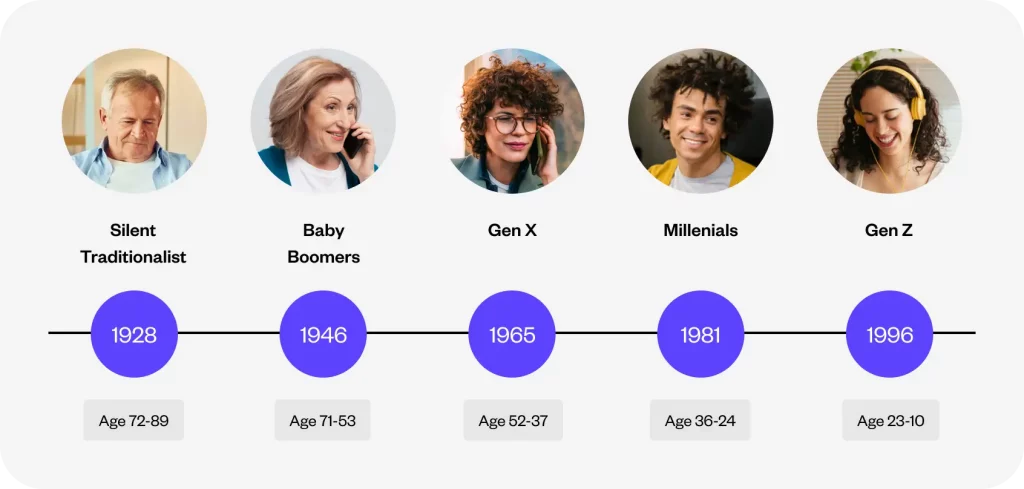
The start and end dates for each of these generations change slightly depending on the source. It’s especially difficult for Millennials. While most experts place this group between 1981 and 1996, it’s not uncommon to come across websites that prolong that timeframe all the way to 2004.
A generation typically lasts 15 to 20 years. That doesn’t feel like a long time to some of us. However, in terms of technology, it is an eternity.
Customer service expectations from generational differences
1. Baby Boomers – born between 1946 and 1964
Not only are Baby Boomers the wealthiest generation, accounting for 70% of disposable income in the United States and spending over $548 billion each year, but they also spend more than any other generation in all categories. This covers the most money spent per transaction.
One widespread misperception regarding elder generations is that they lack technological experience. According to the Pew Research Institute, 67 percent possess a smartphone and 57 percent use social media. Include Boomers in the design of your omnichannel customer experience, whether it’s live chat, a mobile app, social media, or marketing automation.
Besides that, this generation values connections. As a result, when Boomers contact your customer care team, you can expect lengthy conversations. They want customer service staff to be available by phone 24 hours a day, seven days a week, and to provide resolutions the first time they contact them.
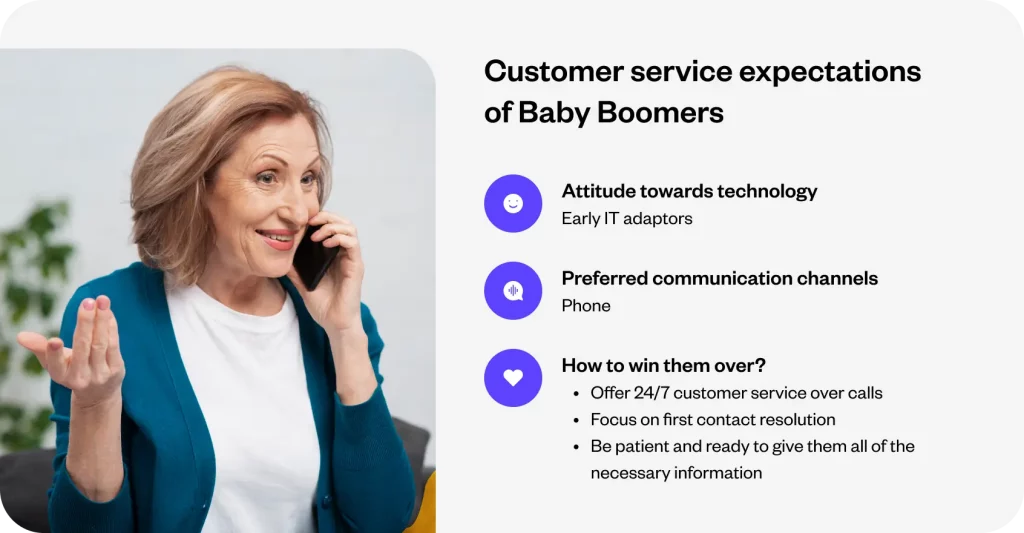
2. Gen X – born between 1965 and 1980
We’re talking about the generation that pioneered American entrepreneurship. They are more digitally sophisticated than their parents, with more than 80% actively using social media.
They are most active on Facebook, LinkedIn and Twitter. Make sure you’re present on such sites so you can respond to your clients’ questions in a timely manner. While they prefer digital customer service channels, they are not afraid of a phone call or a face-to-face conversation.
A consumer from this generation expects a customer service professional to be truthful with them. They look for value in what your product offers and do not simply believe what you say. They spend time investigating your product, reading product reviews and looking for social proof regarding your offering.
A customer service representative should be well-versed in the product, be able to show social proof as well as offer quick and effective answers. Even better, as previously said, this generation actively uses social media, so it would be a good idea to deploy social media chatbots for automating customer support on these channels.
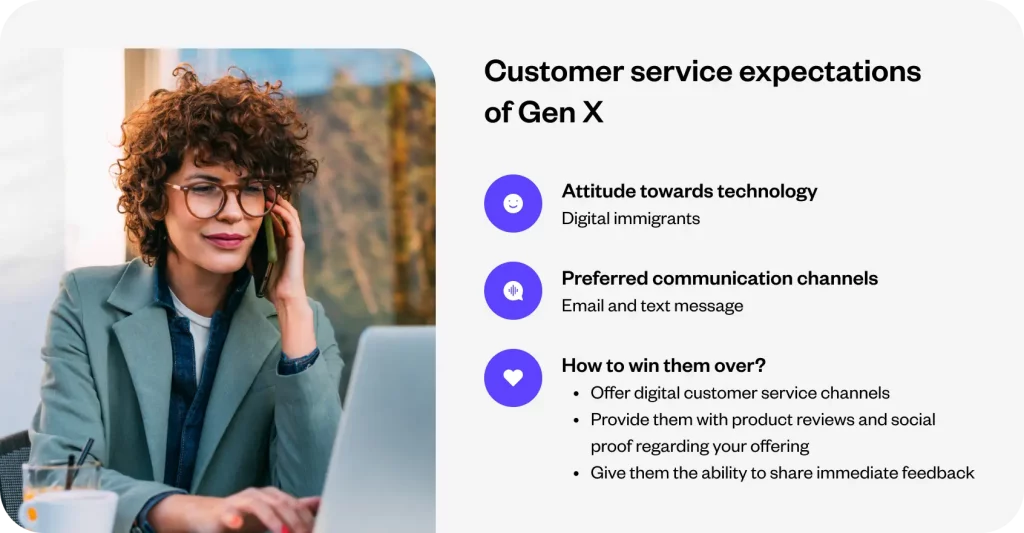
3. Millennials – born between 1981 and 1996
Millennials are the first generation to have grown up with the internet. When Gen X was entering a freshly digital workforce, Millennial children were ringing up their PCs and logging into AOL as the first generation to have access to the internet at home.
As “digital natives,” Millennials have influenced how our modern culture communicates. They’ve pioneered numerous new types of communication, from social media to crowdfunding and even peer-to-peer payments and lending.
Millennials are usually impatient and expect instant gratification. They want a company to provide 24/7 customer assistance via any available channel, from chatbots to Facebook Messenger.
A Millennial customer is even willing to share personal information with a company in exchange for a tailored experience. They want a company to keep their information and service history secure and use it to deliver personalized services.
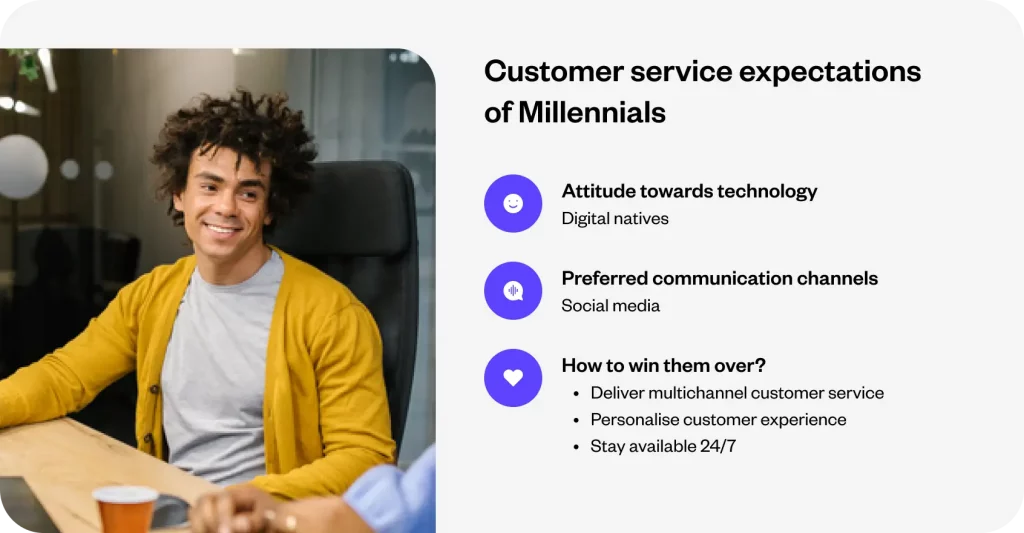
4. Gen Z – born between 1997 and 2012
People’s attention spans are getting shorter and shorter, and this is especially true for Gen Z.
This is the youngest generation of customers, also called ‘the true products of the internet’. They have been exposed to the internet and social media networks from a very young age and have grown up under its influence.
This generation is obsessed with social media. They not only use it to interact with their friends and family, but also with the brands they buy from.
Research indicates that up to 89% of Gen Zs take to social media to share their feedback with their friends and family. While it’s good if you provide them excellent customer service, it can be detrimental if they are unhappy with your service.
To make sure you delight this generation of customers, it’s important to send real, on-brand messages. Having an omnichannel presence will also assist your company in connecting with this younger generation of consumers.
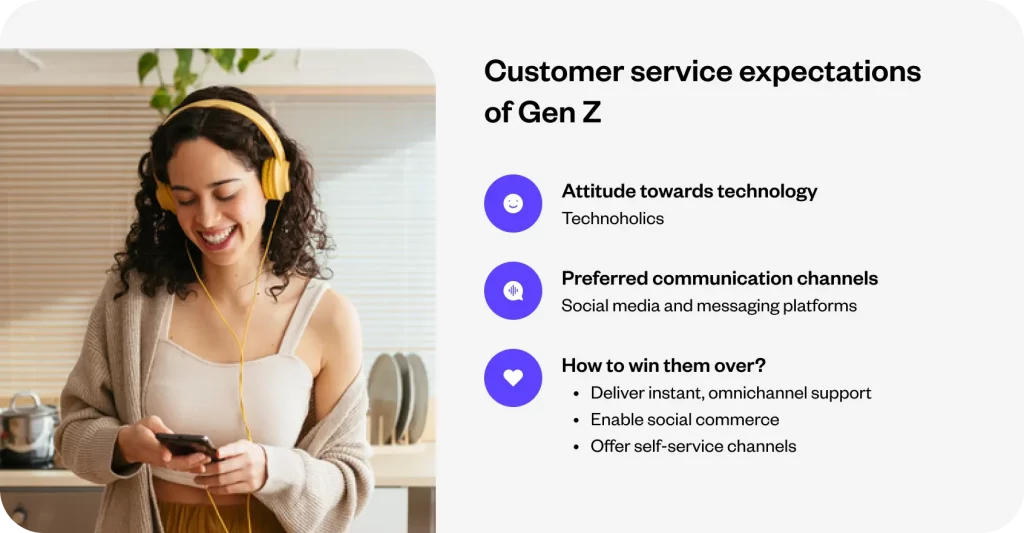
To sum up
Each generation of customers come from different backgrounds and have had different experiences. While some value one-to-one interactions, others prefer to do things on their own. Similarly, while some customers may prefer to interact with you over phone, others would like to solve their own problems with the help of chatbots.
Unless you serve a single generation, it is in your best interests to bridge generational gaps when communicating with your clients. Despite disparities in customer service expectations, one aspect is shared by Boomers, Gen X, Millennials and Gen Z – they all want to be heard, they all want you to value their time and care for their individual needs and requirements.
This is where a next-gen Conversational AI platform such as Yellow.ai can help. The Dynamic AI agents that you can create with the help of pre-built templates on our platform can help you service customers belonging to different generations easily.
These intelligent agents understand the unique needs and intent of individual customers and deliver personalized experiences across customer journeys. They help you offer multilingual, round-the-clock support on multiple platforms so that you are able to meet customers where they are.
Request a demo or take a free trial to see how you can create meaningful customer experiences for clients belonging to all generations using our platform.

















